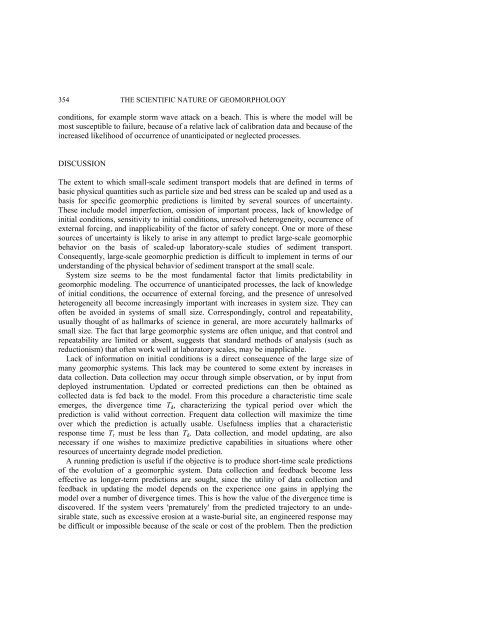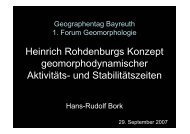Chapter 14 - Limitations on Predictive Modeling in Geomorphology ...
Chapter 14 - Limitations on Predictive Modeling in Geomorphology ...
Chapter 14 - Limitations on Predictive Modeling in Geomorphology ...
Create successful ePaper yourself
Turn your PDF publications into a flip-book with our unique Google optimized e-Paper software.
354 THE SCIENTIFIC NATURE OF GEOMORPHOLOGY<br />
c<strong>on</strong>diti<strong>on</strong>s, for example storm wave attack <strong>on</strong> a beach. This is where the model will be<br />
most susceptible to failure, because of a relative lack of calibrati<strong>on</strong> data and because of the<br />
<strong>in</strong>creased likelihood of occurrence of unanticipated or neglected processes.<br />
DISCUSSION<br />
The extent to which small-scale sediment transport models that are def<strong>in</strong>ed <strong>in</strong> terms of<br />
basic physical quantities such as particle size and bed stress can be scaled up and used as a<br />
basis for specific geomorphic predicti<strong>on</strong>s is limited by several sources of uncerta<strong>in</strong>ty.<br />
These <strong>in</strong>clude model imperfecti<strong>on</strong>, omissi<strong>on</strong> of important process, lack of knowledge of<br />
<strong>in</strong>itial c<strong>on</strong>diti<strong>on</strong>s, sensitivity to <strong>in</strong>itial c<strong>on</strong>diti<strong>on</strong>s, unresolved heterogeneity, occurrence of<br />
external forc<strong>in</strong>g, and <strong>in</strong>applicability of the factor of safety c<strong>on</strong>cept. One or more of these<br />
sources of uncerta<strong>in</strong>ty is likely to arise <strong>in</strong> any attempt to predict large-scale geomorphic<br />
behavior <strong>on</strong> the basis of scaled-up laboratory-scale studies of sediment transport.<br />
C<strong>on</strong>sequently, large-scale geomorphic predicti<strong>on</strong> is difficult to implement <strong>in</strong> terms of our<br />
understand<strong>in</strong>g of the physical behavior of sediment transport at the small scale.<br />
System size seems to be the most fundamental factor that limits predictability <strong>in</strong><br />
geomorphic model<strong>in</strong>g. The occurrence of unanticipated processes, the lack of knowledge<br />
of <strong>in</strong>itial c<strong>on</strong>diti<strong>on</strong>s, the occurrence of external forc<strong>in</strong>g, and the presence of unresolved<br />
heterogeneity all become <strong>in</strong>creas<strong>in</strong>gly important with <strong>in</strong>creases <strong>in</strong> system size. They can<br />
often be avoided <strong>in</strong> systems of small size. Corresp<strong>on</strong>d<strong>in</strong>gly, c<strong>on</strong>trol and repeatability,<br />
usually thought of as hallmarks of science <strong>in</strong> general, are more accurately hallmarks of<br />
small size. The fact that large geomorphic systems are often unique, and that c<strong>on</strong>trol and<br />
repeatability are limited or absent, suggests that standard methods of analysis (such as<br />
reducti<strong>on</strong>ism) that often work well at laboratory scales, may be <strong>in</strong>applicable.<br />
Lack of <strong>in</strong>formati<strong>on</strong> <strong>on</strong> <strong>in</strong>itial c<strong>on</strong>diti<strong>on</strong>s is a direct c<strong>on</strong>sequence of the large size of<br />
many geomorphic systems. This lack may be countered to some extent by <strong>in</strong>creases <strong>in</strong><br />
data collecti<strong>on</strong>. Data collecti<strong>on</strong> may occur through simple observati<strong>on</strong>, or by <strong>in</strong>put from<br />
deployed <strong>in</strong>strumentati<strong>on</strong>. Updated or corrected predicti<strong>on</strong>s can then be obta<strong>in</strong>ed as<br />
collected data is fed back to the model. From this procedure a characteristic time scale<br />
emerges, the divergence time T d , characteriz<strong>in</strong>g the typical period over which the<br />
predicti<strong>on</strong> is valid without correcti<strong>on</strong>. Frequent data collecti<strong>on</strong> will maximize the time<br />
over which the predicti<strong>on</strong> is actually usable. Usefulness implies that a characteristic<br />
resp<strong>on</strong>se time T r must be less than T d . Data collecti<strong>on</strong>, and model updat<strong>in</strong>g, are also<br />
necessary if <strong>on</strong>e wishes to maximize predictive capabilities <strong>in</strong> situati<strong>on</strong>s where other<br />
resources of uncerta<strong>in</strong>ty degrade model predicti<strong>on</strong>.<br />
A runn<strong>in</strong>g predicti<strong>on</strong> is useful if the objective is to produce short-time scale predicti<strong>on</strong>s<br />
of the evoluti<strong>on</strong> of a geomorphic system. Data collecti<strong>on</strong> and feedback become less<br />
effective as l<strong>on</strong>ger-term predicti<strong>on</strong>s are sought, s<strong>in</strong>ce the utility of data collecti<strong>on</strong> and<br />
feedback <strong>in</strong> updat<strong>in</strong>g the model depends <strong>on</strong> the experience <strong>on</strong>e ga<strong>in</strong>s <strong>in</strong> apply<strong>in</strong>g the<br />
model over a number of divergence times. This is how the value of the divergence time is<br />
discovered. If the system veers 'prematurely' from the predicted trajectory to an undesirable<br />
state, such as excessive erosi<strong>on</strong> at a waste-burial site, an eng<strong>in</strong>eered resp<strong>on</strong>se may<br />
be difficult or impossible because of the scale or cost of the problem. Then the predicti<strong>on</strong>








